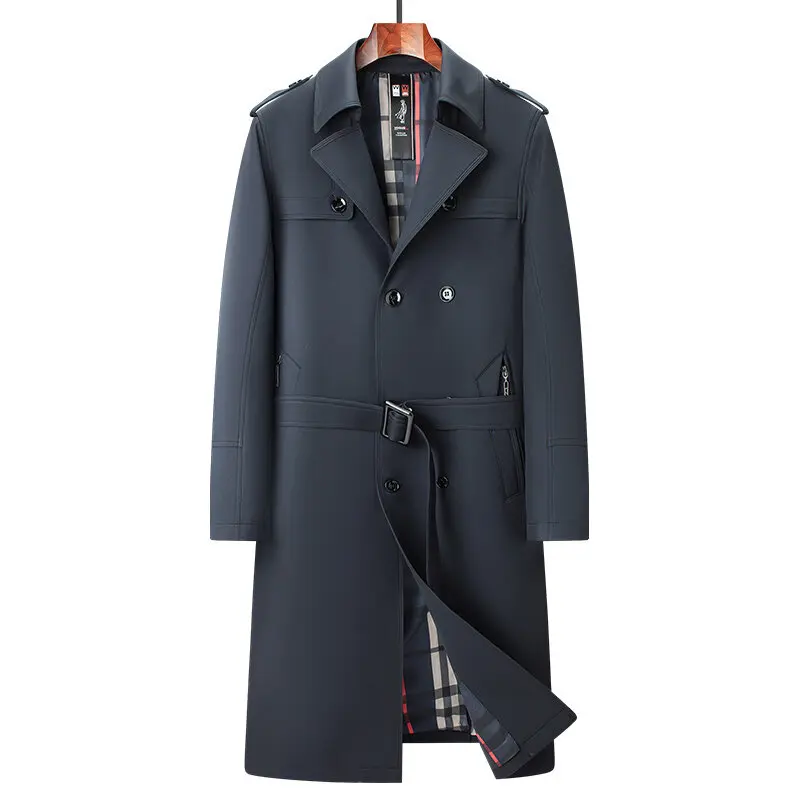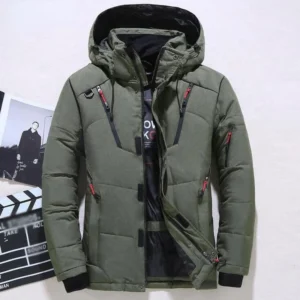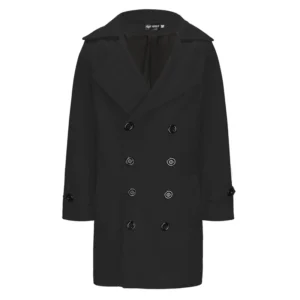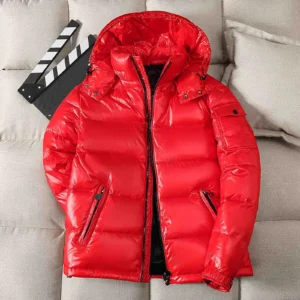Introduction: Understanding the Appeal of Double-Breasted Coats
The double-breasted coat stands as one of menswear’s most distinctive and commanding garments. Characterized by its overlapping front panels and parallel columns of buttons, this coat style creates an unmistakable silhouette that commands attention. What began as practical naval attire designed to protect sailors from harsh elements has evolved into a sophisticated fashion statement embraced by style enthusiasts worldwide.
Double-breasted coats possess an inherent formality and sense of occasion that single-breasted alternatives simply cannot match. The broader chest, defined waist, and structured shoulders create a powerful silhouette that flatters most body types when properly fitted. Despite their formal roots, these coats have proven remarkably versatile, adapting to contemporary fashion while maintaining their classic appeal.
Throughout this guide, we’ll explore everything you need to know about mastering the double-breasted coat—from finding the perfect fit to styling options for various occasions. Whether you’re looking to make a statement in the boardroom or elevate your weekend attire, understanding the advantages of double-breasted coats will help you wear this classic piece with confidence. For those seeking deeper insights, our ultimate guide to men’s double-breasted coats provides comprehensive information on this timeless garment.
Essential Characteristics of Double-Breasted Coats
Understanding the key elements of double-breasted coats is essential to appreciating their design and making informed style choices:
Button Configuration: Double-breasted coats are typically identified by their button arrangement, expressed as “6×2” (six buttons with two functioning), “4×2” (four buttons with two functioning), or similar configurations. The first number indicates total buttons, while the second shows how many actually fasten. A 6×2 arrangement creates a classic, traditional look, while 4×1 offers a more contemporary appearance.
Lapels: Peak lapels are the traditional and most common choice for double-breasted coats. These upward-pointing lapels create a broadening effect across the chest and shoulders, enhancing the masculine silhouette. The width and angle of these lapels significantly impact the coat’s overall appearance.
Structure and Silhouette: Double-breasted coats typically feature a structured design that emphasizes broad shoulders and a defined waist, creating an athletic V-shaped silhouette even on slimmer frames.
Length Variations: From full-length overcoats that extend below the knee to shorter peacoat styles ending at the hip, the length dramatically affects both function and formality.
These distinctive features contribute to the coat’s formal character while also providing opportunities for modern interpretations. When exploring different styles of double-breasted overcoats, you’ll notice how subtle variations in these elements create distinct looks. To better understand what makes this coat style unique, consider the key differences between double-breasted and single-breasted designs.
Critical Rules for Wearing Double-Breasted Coats
Mastering a few fundamental principles will ensure your double-breasted coat always looks sophisticated rather than sloppy:
Buttoning Rules: Unlike single-breasted coats, double-breasted versions follow strict buttoning protocols:
– The anchor/jigger button (the hidden internal button) should always be fastened to maintain the coat’s structure
– Middle row buttons should be fastened when standing to create the proper drape
– Bottom row buttons should never be fastened
– Unbutton completely when seated to avoid unsightly pullingLapel Positioning: The lapels should lie flat against your chest without buckling or gaping. Proper fit ensures they create clean lines from the collar down to the buttoning point.
Maintain Clean Lines: The overlapping front panels should create a smooth, uninterrupted line without pulling or sagging. This depends largely on proper fit.
Embrace Simplicity: Because the double-breasted coat itself makes such a bold statement, overaccessorizing can create visual clutter. Let the coat’s architecture be the focal point.
These conventions aren’t merely arbitrary rules but practical guidelines that enhance the coat’s visual appeal and functionality. For instance, leaving the bottom button unfastened allows for better movement and prevents the coat from pulling at the hips when walking. Understanding proper double-breasted coat buttoning techniques is essential for wearing this garment with confidence and style.
The Perfect Fit: Foundation of Double-Breasted Style
While fit matters for all tailored clothing, it’s particularly crucial for double-breasted coats. Their overlapping front panels and structured design leave little room for error—an ill-fitting double-breasted coat can look awkward rather than elegant.
Key Fit Guidelines:
Shoulders: The shoulder seams should align precisely with your natural shoulder edge. Too wide creates a sloppy, oversized look; too narrow restricts movement and causes pulling across the upper back.
Chest and Waist: The coat should button comfortably without strain. When fastened, you should be able to fit a flat hand inside the coat at chest level but not a full fist. The waist should taper slightly to create shape without pulling at the buttons.
Sleeve Length: Ideally, sleeves should end at your wrist bone, showing approximately ¼-½ inch of shirt cuff when your arms are at your sides.
Overall Length: For overcoats, the hem should cover the seat of your trousers. For shorter peacoat styles, the hem typically falls at hip level.
Collar: The collar should sit flush against your neck without gaping or bunching, even when the coat is fully buttoned.
Fit Assessment:
When trying on a double-breasted coat, button it completely and:
– Raise your arms to shoulder height—there should be enough room for comfortable movement
– Check for pulling across the back or at the button closure
– Ensure the lapels lie flat against your chest
– Confirm the collar sits properly against your neck
Many double-breasted coats will require tailoring for an ideal fit. Simple alterations include sleeve length adjustment and waist suppression, while shoulder alterations are complex and expensive. For comprehensive advice on achieving the perfect silhouette, explore our expert guide to double-breasted coat fit. Understanding the proper full coat length is also essential for selecting the right style for your height and proportions.
Formal Styling: Double-Breasted Coats for Business and Events
Double-breasted coats shine in formal settings, where their structured elegance complements business and occasion wear perfectly. When styled formally, these coats project confidence, sophistication, and attention to detail.
For traditional business attire, pair your double-breasted overcoat with a well-tailored suit in complementary colors. Navy or charcoal overcoats work exceptionally well with most business suits. Under the coat, a crisp white or light blue dress shirt and a silk tie in a subtle pattern create a cohesive formal look. For footwear, Oxford shoes or quality leather dress boots maintain the formal character.
When attending formal evening events, consider a black or deep navy double-breasted coat over formal attire. The coat’s structured silhouette pairs beautifully with formal trousers and dress shoes. Keep accessories refined—a simple white pocket square, quality leather gloves, and perhaps a cashmere scarf in a subtle color.
For less formal business settings, try a double-breasted blazer with contrasting trousers. A navy blazer paired with light gray or tan trousers creates a sophisticated yet slightly relaxed business look. In these settings, you might introduce subtle patterns in your shirt or tie while maintaining an overall polished appearance.
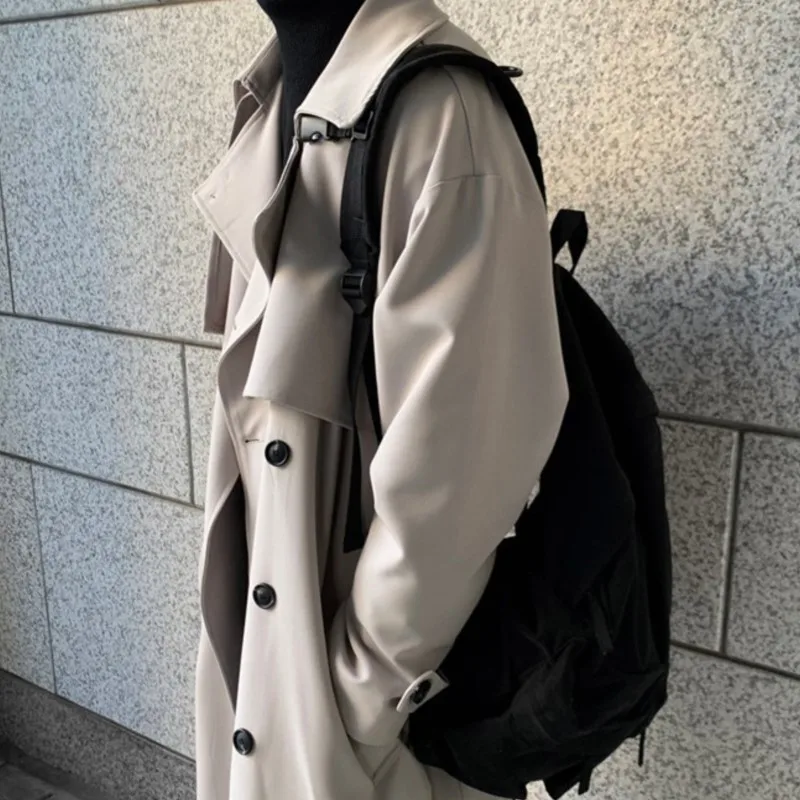
For specific guidance on formal occasions, our guide on mastering formal double-breasted coats provides detailed advice. Metro Cloak offers several wool overcoat options that excel in formal settings, providing both warmth and sophisticated style.
Casual Styling: Making Double-Breasted Coats Approachable
Despite their formal reputation, double-breasted coats can be wonderfully versatile in casual settings when styled thoughtfully. The key lies in balancing the coat’s inherent formality with more relaxed elements.
Start with fabric choice—textured materials like tweed, flannel, or cotton naturally feel less formal than smooth worsted wool or cashmere. Consider colors beyond the traditional navy and gray; burgundy, olive green, or camel can make a double-breasted coat feel more approachable for everyday wear.
For casual bottoms, dark wash jeans create an excellent foundation. The contrast between the structured coat and casual denim strikes an appealing balance between polished and relaxed. Quality chinos or corduroy trousers also pair beautifully with double-breasted coats for a smart-casual look.
Underneath, move beyond dress shirts to explore more relaxed options:
– A fine-gauge turtleneck or roll-neck sweater creates a sophisticated yet relaxed look
– Oxford button-down shirts worn without a tie strike the perfect smart-casual balance
– Quality t-shirts in solid colors can work with shorter double-breasted styles in warmer weather
Footwear choices significantly impact the overall casualness of your look. Consider:
– Leather loafers or driving shoes for a refined casual approach
– Suede desert boots or chukkas for versatile smart-casual styling
– Clean, minimalist sneakers for a contemporary casual interpretation
For a truly relaxed approach, try wearing your double-breasted coat unbuttoned. This immediately softens the look while still showcasing the coat’s distinctive style. This works particularly well with shorter styles like double-breasted pea coats, which naturally lend themselves to more casual interpretations.
Mens Heavy Winter Coat, Mens Insulated Coat, Mens Parka Coat
Price range: $175.52 through $237.36 Select options This product has multiple variants. The options may be chosen on the product pageMens Big and Tall Winter Coats, Mens Down Coat, Mens Hooded Winter Coat, Mens Puffer Coat
Price range: $126.44 through $217.01 Select options This product has multiple variants. The options may be chosen on the product pageMens Big and Tall Winter Coats, Mens Hooded Winter Coat
Price range: $80.32 through $106.68 Select options This product has multiple variants. The options may be chosen on the product pageMens Double Breasted Pea Coat, Mens Wool Blend Coat, Mens Wool Pea Coat
Price range: $136.84 through $157.36 Select options This product has multiple variants. The options may be chosen on the product pageMens Cashmere Overcoat, Mens Hooded Winter Coat, Mens Wool Blend Coat
Price range: $128.72 through $139.68 Select options This product has multiple variants. The options may be chosen on the product pageMens Hooded Winter Coat, Mens Insulated Coat, Mens Puffer Coat, Mens Quilted Coat
Price range: $139.88 through $177.72 Select options This product has multiple variants. The options may be chosen on the product page
Women’s Styling: Double-Breasted Versatility Beyond Menswear
While traditionally associated with menswear, double-breasted coats have become staples in women’s wardrobes, offering versatile styling options that range from powerfully professional to elegantly feminine.
For professional settings, women can leverage the coat’s structured silhouette to create authoritative looks. Pair a well-tailored double-breasted coat with tailored trousers or a pencil skirt, adding a silk blouse or fine-gauge sweater underneath. This combination projects confidence while maintaining femininity through thoughtful proportions and accessory choices.
For everyday elegance, double-breasted coats offer numerous styling possibilities:
– Belt the coat to create a defined waistline and more feminine silhouette
– Pair with wide-leg trousers for a flowing, sophisticated look
– Layer over midi skirts or dresses for balance between structured and fluid elements
The coat’s versatility extends to footwear pairings—from knee-high boots to elegant flats or even fashion sneakers for a contemporary approach. Accessories like scarves, statement earrings, or structured handbags can further personalize the look while complementing the coat’s inherent structure.
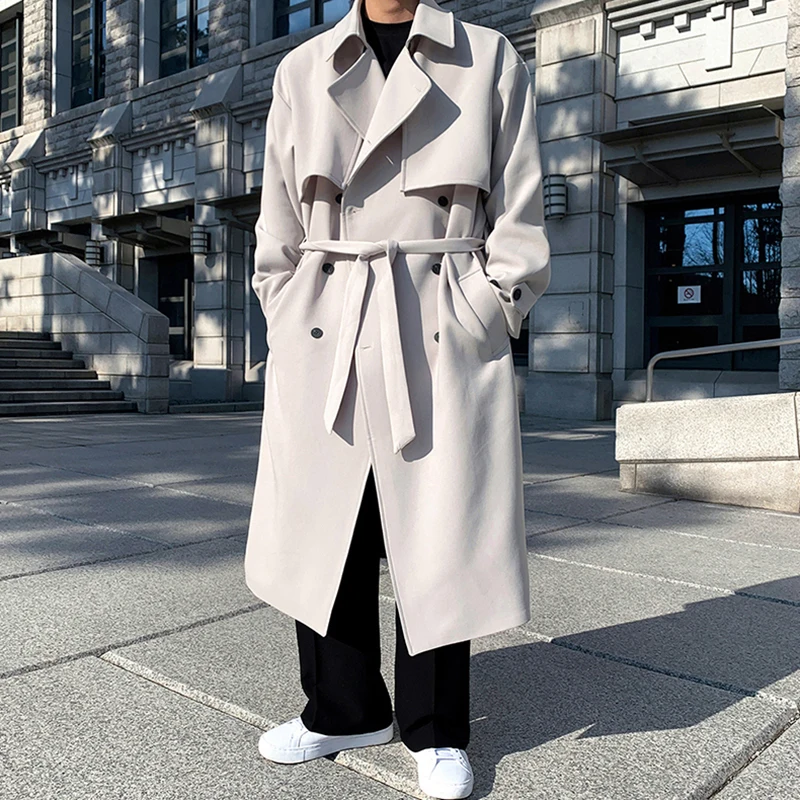
Women can also experiment with proportions, embracing slightly oversized silhouettes for a modern, fashion-forward interpretation, or opting for perfectly tailored fits that accentuate the waistline and create a classic hourglass shape.
Seasonal Styling: Adapting Double-Breasted Coats Year-Round
Double-breasted coats can be adapted across seasons with thoughtful styling and fabric selection.
Winter Styling
For the coldest months, heavyweight wool and cashmere double-breasted overcoats provide exceptional warmth and protection. Layer strategically with:
– Merino or cashmere sweaters underneath
– Scarves that can be tucked inside the overlapping panels for added insulation
– Leather gloves and appropriate headwear for complete cold-weather protection
The coat’s overlapping front panels naturally provide additional warmth across the chest—a functional benefit from its naval origins. For particularly harsh conditions, explore winter coat options designed to combine style with serious weather protection.
Transitional Seasons
Spring and fall call for lighter weight options and adaptable layering:
– Choose medium-weight wool or wool-blend fabrics
– Consider lighter colors that reflect the seasonal change
– Layer over light knitwear that can be removed as temperatures change
– Use the coat as a statement piece over simple, seasonally appropriate basics
Summer Options
While traditionally not summer garments, lighter double-breasted blazers in cotton, linen, or tropical wool can work for summer evenings or air-conditioned environments:
– Opt for unlined or partially lined construction
– Choose breathable natural fibers
– Wear over the lightest possible layers
– Consider lighter colors that reflect rather than absorb heat
By selecting appropriate weights and fabrics, double-breasted coats can provide style and function throughout most of the year.
Color and Pattern: Strategic Choices for Maximum Impact
Your choice of color and pattern significantly impacts how your double-breasted coat is perceived and its versatility in your wardrobe.
Classic Color Options
For maximum versatility, these timeless choices serve as excellent foundations:
– Navy: Perhaps the most versatile color, working across formal and casual settings
– Charcoal gray: Sophisticated and easily paired with most colors
– Camel: A classic with distinctive elegance that complements both formal and casual wear
– Black: Most formal option, perfect for evening events and professional settings
These classic colors form the foundation of a versatile coat collection, with black overcoats offering particular versatility for formal occasions.
Bolder Color Choices
Once you’ve established basics, consider:
– Burgundy: Adds richness while remaining relatively versatile
– Bottle green: A distinctive choice that pairs well with neutrals
– Tan or tobacco brown: Warmer alternatives to camel that work beautifully in casual contexts
Pattern Considerations
Double-breasted coats often work best with subtle patterns that don’t compete with their distinctive structure:
– Herringbone: A classic pattern that adds texture without overwhelming
– Subtle checks: Can add visual interest while maintaining versatility
– Pinstripes: More statement-making and typically best reserved for specific occasions
When selecting patterns, consider scale carefully—smaller, subtle patterns tend to be more versatile than bold, large-scale designs.
Accessorizing Your Double-Breasted Coat
The right accessories complement your double-breasted coat without competing with its bold structure. Strategic accessorizing enhances the coat’s impact while expressing personal style.
Essential Cold-Weather Accessories
- Scarves: Choose weights and materials appropriate to the coat’s formality—silk for formal settings, cashmere or wool for versatility, chunky knits for casual looks
- Gloves: Leather for formal settings (black with black coats, brown with navy or camel), wool or suede for casual contexts
- Hats: Classic styles like fedoras or trilbies complement formal double-breasted coats, while beanies or flat caps work with more casual interpretations
Refined Details
- Pocket squares: For double-breasted blazers or coats worn to formal events, a simple pocket square adds polish without overwhelming
- Lapel pins or flowers: Small, subtle options can personalize your look while respecting the coat’s already strong visual presence
- Watches and cufflinks: Should complement the coat’s level of formality
Remember that the double-breasted coat itself makes a strong statement, so accessories should enhance rather than compete with this central element. The principle of “less is more” often applies—choose fewer, higher-quality accessories rather than multiple competing elements.
Common Styling Mistakes and How to Avoid Them
Even with the best double-breasted coat, certain common mistakes can undermine your look. Recognizing and avoiding these pitfalls ensures you always present this classic garment at its best.
Incorrect Buttoning
The most fundamental mistake is improper buttoning. Never fasten the bottom button, always secure the jigger/anchor button, and keep the coat buttoned while standing. Unbuttoned double-breasted coats can look sloppy unless deliberately styled for a very casual look.
Fit Issues
An ill-fitting double-breasted coat can appear awkward rather than elegant:
– Too tight across the chest creates unsightly pulling and prevents the front panels from lying flat
– Too loose results in a shapeless silhouette that undermines the coat’s structured elegance
– Incorrect sleeve or body length disrupts the coat’s proportions
Inappropriate Styling for the Occasion
Double-breasted coats vary in formality—full-length wool overcoats are generally more formal than shorter styles or those in more textured fabrics. Choosing the wrong style for the occasion can make you appear either overdressed or underdressed.
Unbalanced Proportions
The double-breasted coat’s distinctive shape needs to work harmoniously with the rest of your outfit:
– Very slim trousers can look unbalanced under a traditional double-breasted coat
– Overly casual footwear may clash with the coat’s inherent formality
– Bulky layers underneath can distort the coat’s clean lines
For comprehensive advice on wearing these distinctive garments appropriately, explore our definitive guide to wearing double-breasted coats, which addresses common challenges and provides practical solutions.
Is a Double-Breasted Coat Right for Your Body Type?
While anyone can wear a double-breasted coat with proper fit and styling, understanding how these garments interact with different body types helps achieve the most flattering result.
Taller Frames
Taller individuals generally have more flexibility with double-breasted styling:
– Can wear both longer overcoats and shorter peacoat styles
– May benefit from horizontal elements that the parallel button rows provide
– Should ensure proper sleeve and body length, as standard sizes might run short
Shorter Stature
Those with shorter frames can absolutely wear double-breasted coats with these considerations:
– Opt for higher button stances that create the illusion of longer legs
– Consider shorter coat lengths that don’t overwhelm the frame
– Vertical peak lapels can create a lengthening effect
– Ensure the coat doesn’t extend too far below the hip (for blazers) or knee (for overcoats)
Broader Builds
The double-breasted coat’s structure can work wonderfully for broader frames:
– The coat’s defined waist can create or enhance a V-shaped silhouette
– Proper tailoring is essential to accommodate shoulders without excess fabric elsewhere
– Lower button stances can help create balance
Slimmer Frames
Those with slimmer builds can use double-breasted coats to add perceived bulk:
– The overlapping front panels add visual weight to the chest
– Structured shoulders create the appearance of broader upper body
– Consider slightly padded options that enhance the shoulders
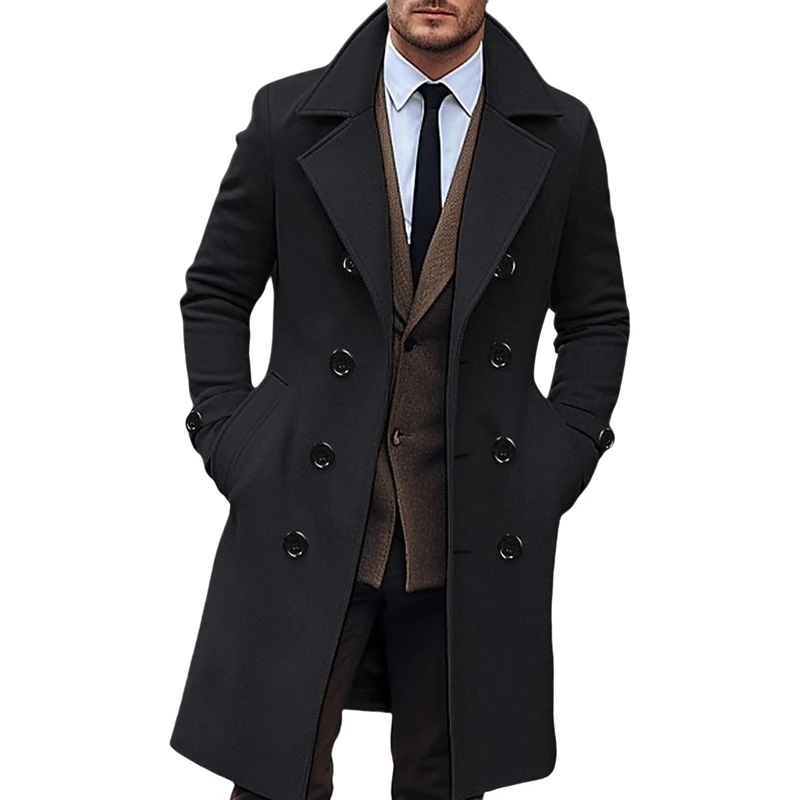
The universal principle across all body types remains proper fit—a well-tailored double-breasted coat can flatter any physique when proportioned correctly.
Caring for Your Double-Breasted Coat
A quality double-breasted coat represents a significant investment that can last for years with proper care. Follow these guidelines to maintain your coat’s appearance and extend its life:
Proper Hanging: Always use broad, sturdy wooden hangers that support the coat’s shoulders properly. The coat’s weight and structure make proper hanging essential to maintain its shape.
Regular Maintenance: Brush your coat regularly with a clothes brush to remove surface dirt and debris before it becomes embedded in the fabric. Pay special attention to areas like collar, cuffs, and front panels.
Cleaning Protocols:
- Spot clean minor stains promptly with appropriate products for the fabric
- Dry clean only when necessary (typically once or twice a season)
Always follow care instructions specific to your coat’s fabric
Seasonal Storage:
- Before storing for off-seasons, ensure the coat is clean
- Use breathable garment bags rather than plastic
- Consider cedar blocks or other natural moth deterrents
Store in a cool, dry place away from direct sunlight
Button Maintenance: Check and tighten buttons regularly—especially the anchor/jigger button that receives regular stress.
With proper care, a quality double-breasted coat from Metro Cloak can serve as a wardrobe cornerstone for many years, making it a worthwhile investment in your personal style.
Can You Break the Rules? Modern Interpretations of Double-Breasted Style
While traditional rules provide a foundation for wearing double-breasted coats well, contemporary fashion has introduced more flexible interpretations that can work beautifully when executed with intention and confidence.
Modern approaches include:
Relaxed Silhouettes: Slightly less structured cuts that maintain the distinctive double-breasted appearance while feeling less formal and rigid.
Creative Layering: Pairing double-breasted blazers with unexpected items like quality hoodies, turtlenecks, or even the right t-shirts for a high-low contrast.
Contemporary Proportions: Shorter lengths, slimmer cuts, and higher armholes that create more youthful, fashion-forward interpretations.
Unconventional Materials: Beyond traditional wool, exploring cotton, linen, velvet, or even technical fabrics for specialized performance.
The key to successful rule-breaking lies in understanding the rules first—intentional deviation looks deliberate and stylish, while ignorance of conventions often simply looks incorrect. Our classic double-breasted coat guide provides the traditional foundation from which modern interpretations can thoughtfully evolve.
When considering contemporary styling, remember that the most successful approaches maintain the coat’s fundamental strengths—its distinctive silhouette, flattering structure, and inherent elegance—while adapting secondary elements to modern tastes and needs.
A quality double-breasted coat, properly fitted and thoughtfully styled, remains one of the most distinctive and sophisticated garments in menswear. Whether embracing traditional styling or exploring contemporary interpretations, this classic piece offers remarkable versatility and enduring appeal.

